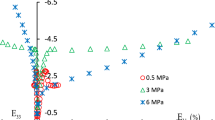Abstract
Fracture process zone (FPZ), or the crack-tip damage zone created by crack-bridging and micro-cracking activities, in a specimen of a concrete-like material is comparable to the crack size and un-cracked ligament, so fracture is typically quasi-brittle. Increasing or decreasing the specimen size, quasi-brittle fracture transition occurs towards the toughness-controlled or strength-controlled fracture, which is known as size effect (SE). In this study it is shown that the “size-dependent” quasi-brittle fracture transition is actually due to the interaction of FPZ with the nearest structure boundary rather than the size variation, and the widely-accepted SE for geometrically-similar specimens of different sizes is only a special case of quasi-brittle fracture controlled by the FPZ/boundary interaction. Relevant SE relations are critically reviewed and explained by emphasizing the key SE mechanism, FPZ/boundary interaction.
Similar content being viewed by others
References
ASTM (1990) E399-90, Standard test method for plane-strain fracture toughness testing of high strength metallic materials. Amer Soc Testing Mater, Philadelphia
Bazant ZP (1984) Size effect on blunt fracture: concrete, rock, metal. J Eng Mech 110: 518–535
Bazant ZP, Kazemi MT (1990) Determination of fracture energy, process zone length and brittleness number from size effect, with application to rock and concrete. Int J Fract 44(2): 111–131. doi:10.1007/BF00047063
Duan K, Hu XZ (2004a) Specimen boundary induced size effect on quasi-brittle fracture. Strength Fract Complex 2(2): 47–68
Duan K, Hu XZ (2004b) Asymptotic analysis of boundary-effect on strength of concrete, In: Li VC, Leung CKY, Willam KJ, Billington SL (eds) Fracture mechanics of concrete structures. In: Proceedings of FraMCoS-5, April 12–16, 2004, Vail, Colorado, USA, Ia-FraMCoS, vol 1, pp 197–204
Duan K, Hu XZ (2006) A simple method for evaluating flaw distributions responsible for size effects in the strength of small-scale silicon specimens. Key Eng Mater 312: 77–82
Duan K, Hu XZ, Wittmann FH (2006) Asymptotic analysis of boundary effects on fracture properties of quasi-brittle materials. Mech Mater 38: 128–141. doi:10.1016/j.mechmat.2005.05.016
Guinea GV, Elices M, Planas J (2000) Assessment of tensile strength through size effect curves. Eng Fract Mech 65: 189–207. doi:10.1016/S0013-7944(99)00115-0
Hillerborg A, Modeer M, Petersson PE (1976) Analysis of crack formation and crack growth in concrete by means of fracture mechanics and finite elements. Cement Concr Res 6: 773–782. doi:10.1016/0008-8846(76)90007-7
Hu XZ (1998) Size effects in toughness induced by crack close to free edge. In: Mihashi H, Rokugo K (eds) Fracture mechanics of concrete structures. Proceedings of FraMCoS-3, Japan. AEDIFICATIO Publishers, Freiburg, Germany, 1998, pp 2011–2020
Hu XZ (2002) An asymptotic approach to size effect on fracture toughness and fracture energy of composites. Eng Fract Mech 69: 555–564. doi:10.1016/S0013-7944(01)00102-3
Hu XZ, Duan K (2005) Size effect on fracture of MEMS materials. J Mater Sci Tech 21(Suppl 1): 47–50
Hu XZ, Duan K (2007) Size effect: influence of proximity of fracture process zone to specimen boundary. Eng Fract Mech 74: 1093–1100. doi:10.1016/j.engfracmech.2006.12.009
Hu XZ, Cotterell B, Mai YW (1985) A statistical theory of fracture in a two-phase brittle material. Proc R Soc Lond A 401: 251–265
Hu XZ, Mai YW, Cotterell B (1988) A statistical theory of time-dependent fracture for brittle materials. Philos Mag 58: 299–324
Karihaloo BL, Abdalla HM, Xiao QZ (2003) Size effect in concrete beams. Eng Fract Mech 70: 979–993. doi:10.1016/S0013-7944(02)00161-3
Author information
Authors and Affiliations
Corresponding author
Rights and permissions
About this article
Cite this article
Hu, X., Duan, K. Size effect and quasi-brittle fracture: the role of FPZ. Int J Fract 154, 3–14 (2008). https://doi.org/10.1007/s10704-008-9290-7
Received:
Accepted:
Published:
Issue Date:
DOI: https://doi.org/10.1007/s10704-008-9290-7




